CURRENT EXHIBITION
Process
Jan 3–Feb3

Dillon Gallery: Process — Kathleen Draper Garner, Ken Lindgren, Pam Golden, Jess Hurley Scott, Jeanne Wiley
Opening Reception: Thursday, January 10, 6–8 pm
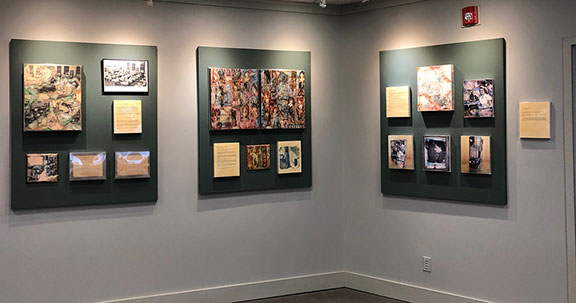
Kathleen Draper Garner
Artist statement
I am intrigued by the stories we tell: myths, fairy tales, and the retelling of ancestral memories. These are recurring themes in my work.
I begin with a visual story in mind. In this show, for example, the inspiration may be poetry, old black and white photographs, or a trip to a 15th century church in England.
The narrative grows as I work. Images are applied or painted, and sanded to a ghost of themselves. Texture changes through the process and images overlap. Composition moves in unintentional directions and new shapes reveal themselves.
I feel the art work developing naturally with me nudging it along, taking it where it wants to go.
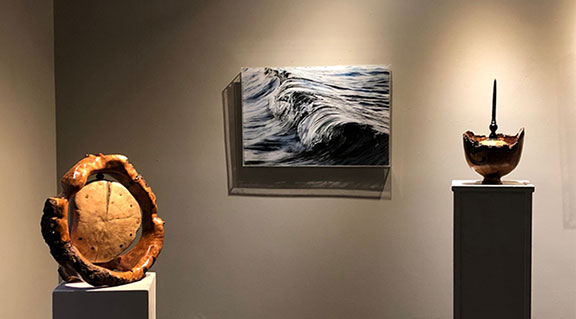
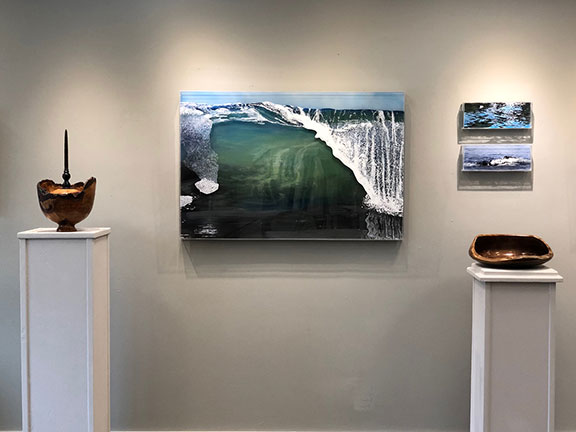
Ken Lindgren and Jess Hurley Scott
Ken Lindgren
Walk Softly Wood
Woodturning is a “process” documented to be more than 2,000 years old.
From its beginnings, it has been used to produce both functional and artistic pieces. The basic process involves harvesting wood from the trunks and limbs of trees. Harvested wood is sawn into a size appropriate for the piece to be made/turned. Then, a mechanical device, called a lathe, is used to not only hold the wood, but also allow it to be rotated freely. As the wood spins, the artist presses a sharpened metal tool against the wood to carve it to the desired shape. The energy created by spinning allows wood to be carved much more quickly than if done by hand with a conventional knife.
Objects made by woodturning includes: bowls, platters, goblets, candle sticks, boxes, urns, rings, bracelets, pendants, balusters, newel posts, chair and table legs, baseball bats, spinning tops, dredels, picture frames, trivets, cutting boards, table and floor lamps, ship masts, tool handles, ornaments, artistic sculptures, and the list goes on and on.
Real wood artists do not touch living trees. Wood is resurrected from what is affectionately called the Horizontal Forest; trees fallen due to natural death, storm damage, or industrial and residential construction. A single large tree can provide enough wood to make over 100 good size salad bowls. In New England we are blessed to be in one of the wood capitals of the world. We have 88 different species of trees with an estimated population of 2,600,000,000. Sadly the number of trees, beneficial to our health and environment, on our planet is declining at an alarming rate.
As you experience my work, if you find it pleasant to your eyes, gentle to your touch and thought provoking to your mind, my mission has been accomplished.
Thank you
Jess Hurley Scott
My work consists of painting on acrylic panels. The images are hand painted on the back of the glass, in reverse- mirror image, and separated into multiple layers to create a dimensional effect. I like blurring the definition of 2D and 3D in my work.
Painting on acrylic has its own set of rules.
I love painting in translucent layers allowing the light to filter through the panels. As I paint in reverse, I have to plan out all of my marks. My first mark on the layer has to be the top highlight, and I work backwards. When I paint, I think more three dimensionally than two. I found out in college I had dyslexia, and in this case, I think it went from my handicap to my superpower.
In my current work, the properties of water, both the tangible and the implied, have been the perfect subject to carry the themes I want to explore. Scientific properties are balanced against the intangible ideas of emotion, drama and instability.
A wave is sheer energy. It can take down a building and yet not support the weight of your hand. The light that reflects and refracts through water may reveal what is under the surface but can also create illusions and distort reality.
On an emotional level, we attach so many different feelings to water, nostalgia, sorrow, anger, peace, it’s amazing. The sea is a constant and powerful force and yet so fragile and easily affected by human influence.
It is this relationship to an ever-changing environment that I find so captivating. There is so much to draw from, I think it’s why I’m still exploring it as a subject.
My painting was influenced heavily by my background in industrial design and graphic work. I loved painting, but traditional painting on canvas felt of a different time to me. I began experimenting with layering and painting on acrylic in 2003. I was trying to find a way to blend traditional painting and something that was my own voice. Over the next 2 years I developed my own technique, I call them dioramic paintings. Landscape is fabulous for this technique and, particularly, water is amazing!
There is a mindfulness in my study of water in this medium. I have always had a love for the ocean. Growing up in Long Island and on the South Shore, it has always drawn me to it. I’m constantly in the water shooting new reference, even in February in a dry suit and booties!
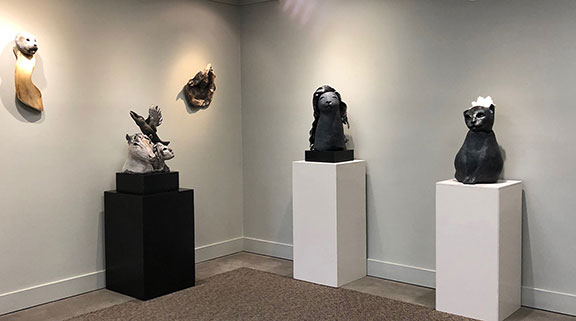
Pam Golden
Clay is an elemental material that transforms with water, air and fire to become something new.
Many of my sculptures are burnished and pit-fired in an ancient traditional manner. How the fire burns
marks the surface of the clay!
Certain mythic stories, and their symbolic meanings, have resonated with me throughout the years.
These sculptures express vivid narrative moments— as a kind of visual storytelling process.
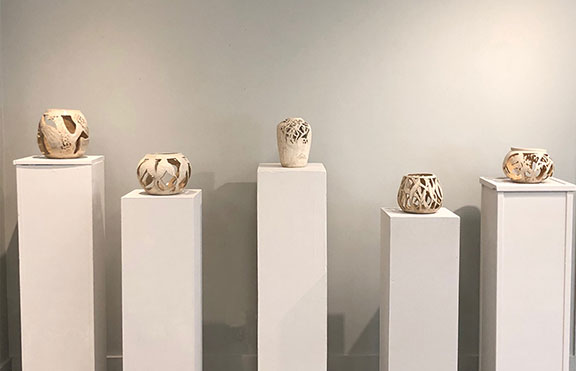
Jeanne Wiley
In an effort to move beyond the functional and find the sculptural in a classic wheel thrown pot, I journeyed down the path of elimination.
Through the process of elimination, I was able to reinterpret the classic wheel thrown vessel, leaving the impression of the pot, without the opacity of the formal form.
Through the process of undoing the form, I was able to create a narrative for these pieces.
The first pot is one of many failures. Through trial and error, I learned how to bring the piece to the edge of collapse. This first pot illustrates what happens when I went beyond the tipping point of structural integrity.
Process
Wheel thrown and trimmed clay pot
Sgraffito surface design
Carve away sections of the pot around sgraffito, leaving the design intact.
Works above by: Ken Lindgren, Jess Hurley Scott, Jeanne Wiley
Manning Lobby Feature: Santiago Hernandez
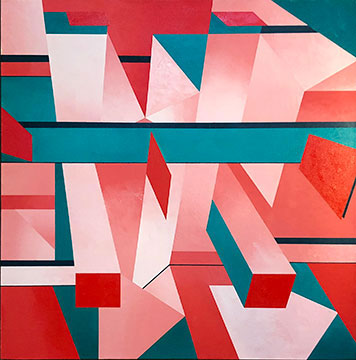
Columna B, 2015
acrylic and oil/canvas. 40 x 40 in
$2400